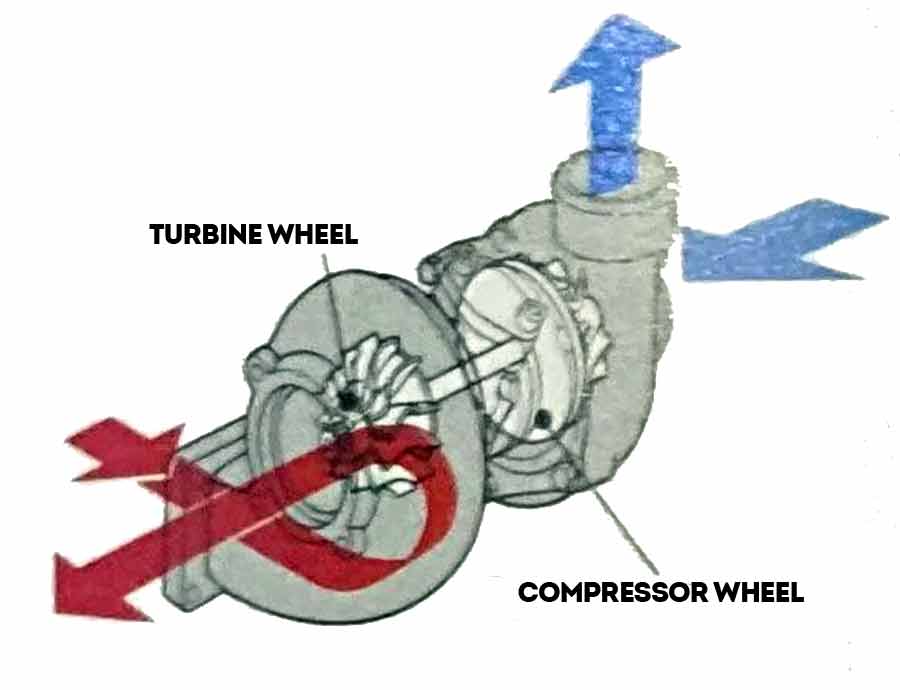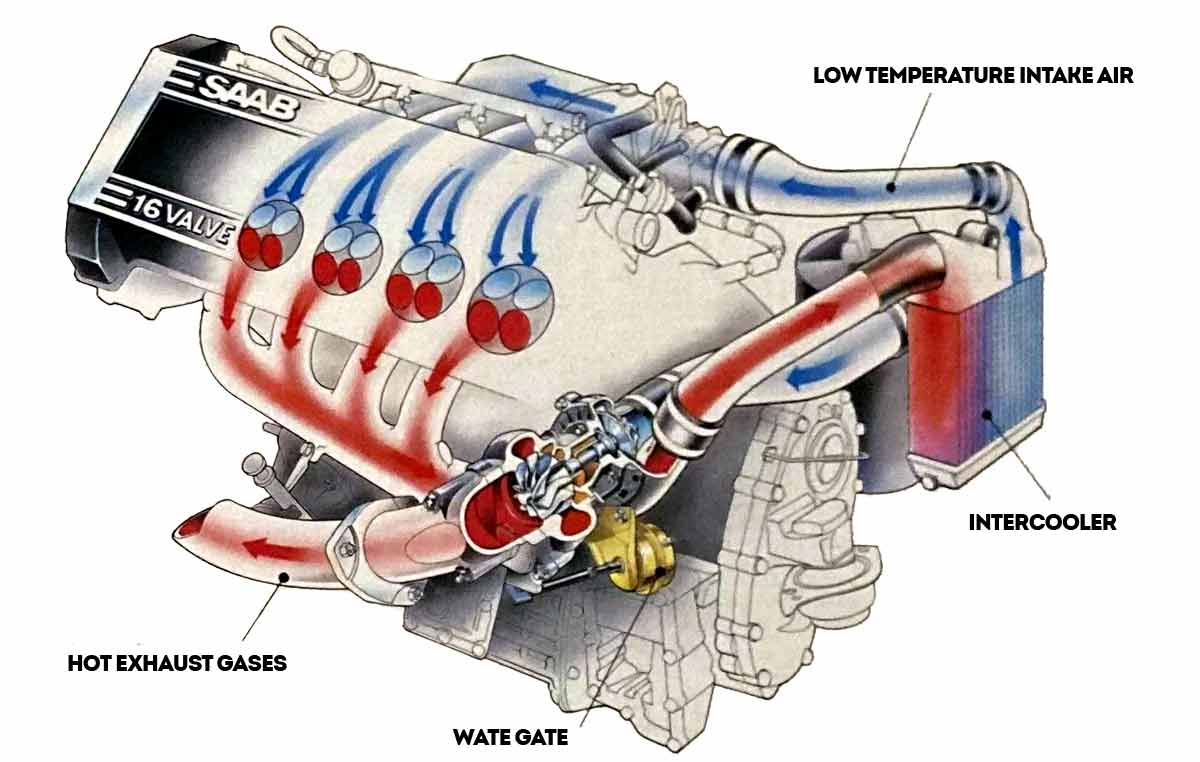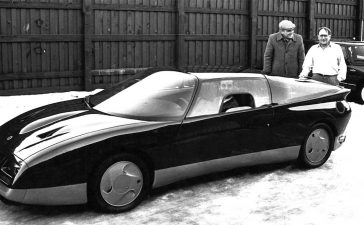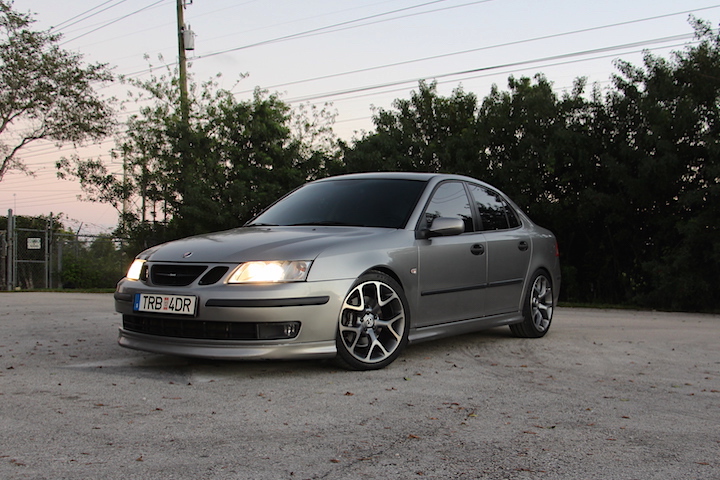All of us who know Saab cars well know that Saab was a pioneer in introducing turbochargers to passenger cars, and that Saab was one of the most successful car companies to integrate turbochargers into all types of engines. With the exception of a couple of engine options, Saab has had almost all turbocharged engines in the last thirty years or so.
Compared to conventional engines of identical power, the fuel consumption of turbocharged engines is lower, and part of the exhaust energy, which is in fact unused, is used in these engines to improve their efficiency.
At higher altitudes, turbochargers that do not have turbochargers may lose power due to lower air pressure. In contrast, turbine efficiency improves under the same conditions due to the increased difference in turbine pressure height and external exhaust pressure, which decreases with increasing altitude. Engines with turbochargers in such conditions suffer almost no power loss.

The essential advantages of using a turbocharger are huge with a few disadvantages, and only some of the advantages are: fast reaction, increased power, increased torque, reduced fuel consumption, environmental benefits and ultimately driving pleasure.
Due to all the above, we need to pay a little attention to the proper use of turbocharged engines in our Saab cars so that they can be used for as long as possible. The turbocharger can withstand really high mileage, but only if it is allowed to do its job in “normal” conditions.
That’s why we give tips on how to extend the life of your turbocharger.
Table of Contents
- 1 Short “warm-up” before normal driving
- 2 Mandatory Warm-up Before Sharp Driving
- 3 Turbocharger Cooling Before Engine Turn Off
- 4 Change the Engine Oil Regularly
- 5 Regular Service Intervals (Filter Replacement)
- 6 Quality and Adequate Engine Oil
- 7 Accelerate in the Appropriate Gear
- 8 React Immediately If Something Is Wrong With the Engine
Short “warm-up” before normal driving
There is no need to warm the engine in place for a long time, especially because it can do more harm than good. Quality oil of appropriate gradation ensures both engine operation and turbocharger operation without damage, even at very low temperatures, whereby the car can be started after only a minute or two. The point is to just wait for all the working fluids to lubricate all the systems in the engine well, and thus the turbocharger. This is especially important during the winter months and low outside temperatures.

There is also the problem with the mixture of fuel and air that corresponds to a cold engine. In both older and newer engines, regardless of whether it is direct or conventional injection, the longer the engine runs in “cold mode”, the more fuel will “wash” the oil from the cylinder walls, which is a very bad phenomenon.
Engine oil suffers from this by practically diluting it with fuel, but there are other negative effects on the engine and all other components, including the turbocharger. Therefore – even when the temperatures are very low, after a maximum of a minute or two, start slowly. While the engine is cold, drive slowly, without sudden acceleration, without high revs and there will be no problems.
Wait for the whole system to warm up at least to some extent, and then you can gradually accelerate sharper, drive faster. After all, it is written in the instructions for use of the car. The manufacturer (factory) says that no matter how low the outside temperature is, it should start at most after a minute or two.
Mandatory Warm-up Before Sharp Driving
Turbochargers can run at extremely high speeds, even over 250,000 rpm, so it is extremely important that the oil that lubricates it is sufficiently heated. Of course, the turbocharger will not immediately “die” if you start driving like in a race without warming up the engine, but that will definitely shorten its lifespan. The same goes for many other engine parts.
As a reminder, engine oil that lubricates the engine – also lubricates the turbocharger.
It is useful to know that engine oil heats up more slowly than coolant (antifreeze), so even when the engine reaches operating temperature, it does not mean that the oil has warmed up enough to ensure its maximum in terms of quality lubrication. So avoid forcing the car (high revs, sharp accelerations …) even when the engine has reached operating temperature, but wait a little longer for the oil to heat up enough. Of course, some cars provide the ability to see the oil temperature as well.
True, in normal driving, things like this are not particularly important. If you accelerate relatively slightly, do not exceed 2,500 rpm (or 3,500 rpm for diesel engines) – then there is no reason to worry.
Turbocharger Cooling Before Engine Turn Off
Turbocharged engines should not be switched off immediately after the car has been driven, for example:
- at high speed (eg on the highway)
- sporty (high revs and strong accelerations)
- under heavy load (uphill, with a trailer, full of cargo and passengers …)
The problem is that very high temperatures can develop in the turbocharger – up to 1,000 degrees Celsius. If you turn off the engine immediately after a sharp drive, when the turbocharger is literally hot, it will stop circulating oil and air through it, so the oil that remains will practically “fry” in contact with hot parts of the turbocharger.
This phenomenon causes a number of problems, from the contamination of the oil itself with particles that formed after “frying” and oil degradation, to the formation of hard deposits on vital parts of the turbocharger. These deposits are probably the most dangerous, as they subsequently cause a whole host of other negative phenomena.
It is recommended that after a sharp / sporty or heavy-duty ride, the engine be left in place for at least another 1 minute or 2 minutes for some. Or to cool off with a subsequent “light ride”.
You can also cool the turbocharger while driving! Before stopping, slow down, do not accelerate and a few kilometers of such a ride should be more than enough to cool everything so that you can easily turn off the engine the moment you stop. If you give the engine another 15-30 seconds in idle, it will certainly not “bother” the engine and turbocharger.
However, in many car forums across the Internet, you will come across claims that all modern cars do not need any “cooling” of the turbocharger because they have “water cooling”. This is simply not true and blindly following such advice can be costly. It is true that some cars have turbochargers that either continue to circulate oil even when the engine is turned off or have water cooling (connected system to the engine cooling system) that can function in several ways.
However, most experts say that it is definitely worth “sacrificing” a minute or two and giving the engine and turbocharger time to “calm down” and cool down, even if they have some of the cooling systems after the engine is turned off.
Change the Engine Oil Regularly
There is a whole list of reasons why you should change the oil earlier – 15,000 or 10,000 kilometers, and not 30,000 kilometers, as indicated by most instructions for the use of cars, including those for Saab cars.
The car user manual often states that the service interval should be halved, ie that the oil change should be done at 15,000 instead of 30,000 km if the car is driven in difficult conditions, which means a lot of city driving, frequent short rides with cold starts, infrequent use vehicles, a lot of idle work (eg 50% of the total time the engine is running) …
Even when we include in the story the regeneration of DPF and other reasons why oil is diluted with fuel and polluted with various particles that can be extremely hard, so they act literally like sandpaper on various engine parts, including turbocharger bearings…
Too long an oil change interval, especially if the oil is contaminated with abrasive particles that “sand” the metal, can lead to accelerated wear of turbocharger parts, which can cause loss of rotor balance, oil leakage due to increased clearance, etc.
Regular Service Intervals (Filter Replacement)
It is not just a matter of regularly changing the engine oil, as other consumable parts that change during a small service or at a certain mileage can cause a problem.
Air filter – in case of its damage or disintegration, everything can reach the turbocharger blades. Even if they do not cause serious damage at the same time, minimal damage that is not immediately noticeable can upset the balance in the turbocharger, which will cause more and more problems over time.
Oil filter – we have already emphasized how important oil is for a turbocharger, and if the filter “breaks down” it can lead to clogging of some oil lines and the like, which can also lead to damage to the turbocharger relatively quickly. Aside from the fact that the filter does not perform its basic function, as well as being able to obstruct the flow of oil.
Quality and Adequate Engine Oil
Quality oil is not only important because of the turbocharger, but it should also be appropriate because of the DPF if it is a diesel (diesels with DPF require special oil, although it has long been known).
For Saab cars, 5W-30 oil is required for diesel with TiD (DTH) engines, while for more powerful TTiD engines (DTR) only 0w-40 oil is required, and both should be Dexos2 compatible.
Accelerate in the Appropriate Gear
Because turbo engines have high torque at low speeds, and can develop maximum torque over a wide range of egine speeds, many drivers “abuse” it. They press the accelerator pedal hard at low revs instead of shifting into a lower gear before accelerating sharply, which negatively affects the turbocharger (but also the dual mass flywheel, among other things).
React Immediately If Something Is Wrong With the Engine
Engine failures, such as poor combustion, can have a very negative effect on the turbocharger. From the accumulation of soot, pollution and dilution of engine oil with fuel, to excessive exhaust gas temperatures. Of course, due to poor combustion, there can be accelerated accumulation of soot on various sensors, EGR, catalytic converter, intake manifold and DPF, oil pollution, which is certainly not good for a turbocharger, so it easily leads to even bigger and more expensive failures on the car.
Therefore, do not delay going to the service when you notice an irregularity in the operation of the engine – it may be a banal thing that can be solved quickly and cheaply, but if you leave it longer it can cause much more expensive failures.
Also fix any problems with DPF or catalyst in time – if DPF becomes too clogged with soot or ash particles, there may be too much pressure in the exhaust system, which is very harmful to the turbocharger.











